Early Office Museum
Antique Office Photographs
~ 1912-1914 ~
When no date is provided in the Description column below, we
do not know the date of the image or photograph.
We have placed undated images and photographs in their likely chronological
order.
If the Source in the right-hand column is anything other than "Early Office
Museum Archives,"
we do not have the ability to grant permission for use or to provide a high
resolution image.
|
Click Image to Enlarge |
Description | Source |
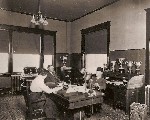 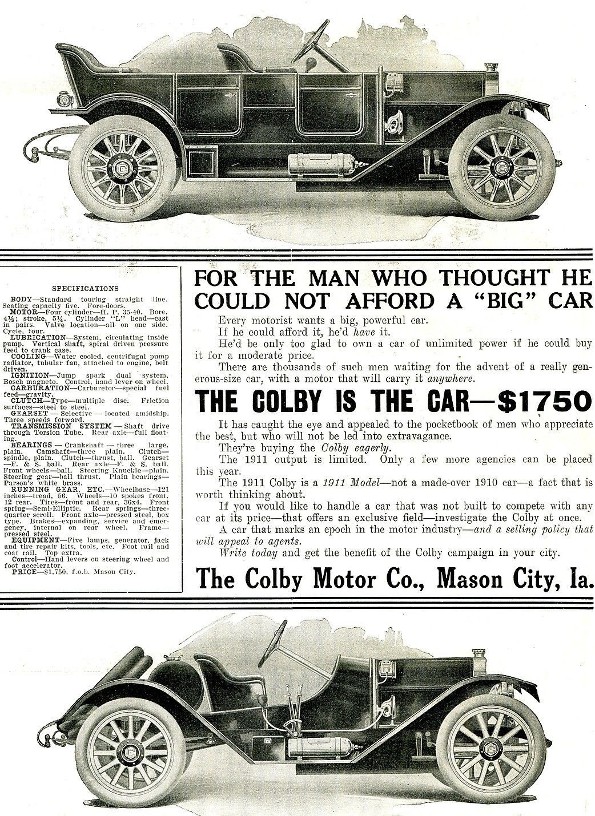 1910 Colby Motor Co. advertisement |
Office of the Colby Motor Co., Mason City, IA, 1912 or 1913. Mason City is located in north-central Iowa near the border with Minnesota. In 1910 its population was 11,230. In the center of the photo is James A. Colby (1878-1954), Vice President. On the left is the company stenographer, his niece, Aline Colby (Aline Colby Griffin after her 1923 marriage) (1891-1964). On the right is Hugh S. Murphy, Manager. The Colby Motor Co. was founded in 1910 by William Martin Colby (1875-1926), who served as President. William Colby had previously built successful companies that produced cement, bricks, tiles, and sewer pipes. William and James Colby were brothers; a third brother, Dwight Colby, also worked at the company. In a 1954 letter, Aline Colby Griffin stated that this photo shows "the various trophies won by the old Colby car - various models. The Model H, which sold for $1750 during those years [see advertisement to the left], won the large trophy on the safe for its Endurance Run [from Minneapolis, Minnesota] to Helena, Montana, in 1912." The 40-horsepower Model H was also called the Colby 40. "The five other trophies were presented to the Colby Motor Company for various other races - one I am sure was awarded for the Colby Red Devil, a racing car." It seems likely that all five of these trophies were won by the Red Devil during 1911. In Oct. 1911, Colby's race driver, Bill Pearce, died when the Red Devil went off the track while he was practicing at high speed. The Red Devil was repaired but reportedly did not raced again. In 1912 the Colby Motor Co. introduced a 30-HP Model L underslung roadster priced at $1250. In 1913 the company introduced a 60-HP 6-cylinder Model C-Six and a 50-HP Model E. Late in 1913 it was reported that the Colby Motor Co. had been acquired by a group of investors and renamed the Standard Motor Co., and that the new company intended to manufacture Colby cars as well as other vehicles at the Mason City factory. This acquisition may not have been consummated; as we will see below, the Colby Motor Co. went into receivership in 1915. According to a 1955 publication, "Competition from Detroit, closer to the source of raw materials and more able to use mass production economies, finally sounded the knell of the Mason City enterprise. In 1915 the Colby Motor Company went into receivership." (Mason City Globe Gazette, Feb. 21, 1955, p. 6) Second-hand accounts published long after 1915 indicate that the Colby Motor Co. produced a total of no more than 1000 cars; these accounts do not identify the source of the production figures, so the number may not be accurate. A 1911 Colby Model D Semi-racer is in the Kinney Pioneer Museum, Mason City, IA. That museum states that this is the only surviving Colby car. |
Early
Office Museum Archives |
 |
General View of the Office, Renaud, Lèvêque et Tripette, Paris, France, 1912. We found no information on a company with this name. However, as of 1910, Renaud et Tripette, a French company, supplied machinery for use by producers of seeds, and as of 2011 Tripette et Renaud, a French company, supplied a range of machinery used in handling grain. | Early
Office Museum Archives |
 |
Office with vault, Iowa, 1912. The vault is through the elaborate doorway at the rear of the room. There is a Protectograph check protector on the high desk and a Burroughs Adding Machine next to the desk. A wall calendar advertises the City National Bank of Clinton, Iowa. This may be an office in that bank, or in a branch of that bank. | Early Office Museum Archives |
 |
Office with eleven typists using Bar-Lock typewriters, England, 1912. Dated by wall calendar. | Early Office Museum Archives |
| Correspondence Division, Circulation Department, Curtis Publishing Co., Philadelphia, PA, postcard, postmarked 1912. Cyrus H. K. Curtis began a publishing business in Philadelphia in 1876 and started publishing The Ladies Home Journal in 1883. In 1890, Curtis formed the Curtis Publishing Co. and took over publication of The Saturday Evening Post. On left, workers, virtually all male, are using dictating machines. On right, other workers, all female, are using transcription machines and typewriters. | Early Office Museum Archives |
|
| Subscription Division, Circulation Department, Curtis Publishing Co., Philadelphia, PA, postcard. See preceding row. | Private collection | |
 |
Office with 15 men and 10 women, Indianapolis, IN, 1912. | Early Office Museum Archives |
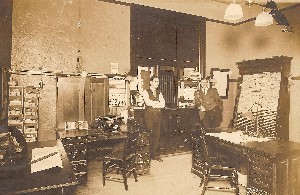 |
Ticket Office with calendar for the Denver & Rio Grande Railroad. According to Wikipedia, the Denver & Rio Grande started as a narrow gauge line running south from Denver, CO, in 1870. It served mainly as a transcontinental bridge line between Denver and Salt Lake City, UT. This railroad had a motto Through the Rockies and operated the highest mainline rail line in the US, over the 10,240 feet Tennessee Pass in Colorado. At its height around 1890, this railroad had the largest operating narrow gauge network in North America. | Early Office Museum Archives |
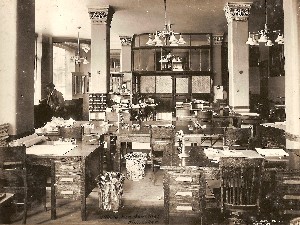 |
General Office, Milwaukee Sentinel, Milwaukee, WI. The Milwaukee Sentinel was founded in 1839. In 1995 it merged with the Milwaukee Journal to become the Milwaukee Journal Sentinel. | Early Office Museum Archives |
   |
Three photos of the same man in his office. This
office appears to be at a mining company because there are ore samples on
the top of the roll-top desk and on and in a cabinet. The photograph above the desk is identified as "Georgetown, Colorado ~ Union Pacific Railroad." Georgetown was a center for silver mining from 1864, when silver was discovered, until 1893, when there was a financial panic and depression. For a time during that period, Georgetown is said to have been the largest producer of silver in the world. A calendar on top of the desk in the first photograph advertises "Salt Lake City Brewing Co." Salt Lake City Brewing was founded by Jacob Moritz and operated from 1881 until at least 1912. |
Early Office Museum Archives |
 |
Order Entry Department, Sears, Roebuck & Co., Chicago, IL, c. 1913. Workers are using Oliver typewriters. | Smithsonian Institution, National Museum of American History. |
 |
City Room at The Detroit News, Detroit, MI, 1913. "Newsmen at work in city room: Arthur Hathaway and behind him William Chattick. Fred Janette at desk in rear." One of the other men is W. S. Gilmore. The Detroit News began publication in 1873 and was still being published in 2010. This photo is dated by a wall calendar. Fred E. Janette was an editor by 1900 and was state editor in 1912 when Hathaway was hired by the newspaper. Arthur I. Hathaway (1891-1985) was city editor at least during 1942-48. W. S. Gilmore (b. 1885) was managing editor in 1931 and editor-in-chief during 1933-1953. During 1942-43, Gilmore was president of the American Society of Newspaper Editors (ASNE). | Early Office Museum Archives |
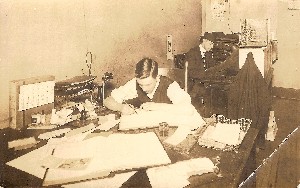 |
Two men in an office. The man in the foreground is using a dip pen and ink well and working on large ledgers. | Early Office Museum Archives |
| Office of the Statesman Journal, Salem, OR, c.1913. Co-owner Carl Abrams reads at desk on far right while Mrs. Abrams types at a roll-top desk center and O.K. DeWitt, smoking a cigar, reads copy. | Salem Public Library Historic Photograph Database, Salem Public Library, Salem, Oregon, Record No. SJ790. | |
 |
Accounting Department, C. G. Conn's Band Instrument Factory, Elkhart, IN, 1913. C. G. Conn and its successor company, Conn-Selmar, a subsidiary of Steinway Musical Instruments, have produced band instruments since 1875. Click here and here to read the company history. There are two Burroughs adding machines in the office. | Early Office Museum Archives |
 |
Office of Gaint Clothes Store, Muskegon, MI, photograph by Ladd & Son. There is a Comptometer Model A calculating machine (sold 1904-06) in front of the woman on the left. The man behind her is working on a Burroughs Class 1 Adding Machine. | Early Office Museum Archives |
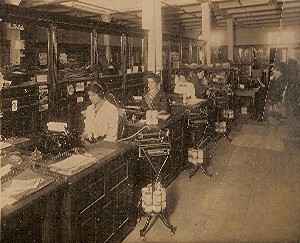 |
Office with two men using dictating machines and three women using transcribing machines, 1913. Dated by calendar top left. [To be rescanned using a larger scanner.] | Early Office Museum Archives |
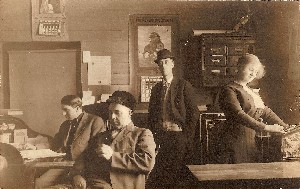 |
Office with calendars advertising brick and lumber companies, 1913. | Early Office Museum Archives |
 |
Office, Dictaphone Corp., Brockton, MA. This office has 16 Model 6 Dictaphone transcription machines. On the second desk on the left sits an American Adder (a.k.a. American Adding Machine No. 5), which was introduced in 1913. | Early Office Museum Archives |
 |
Office with fifteen men and a Remington No. 11 typewriter, 1914. | Early Office Museum Archives |
 |
Office interior, Denver, Colorado. 1914. Photograph includes a letter copying press and a safe with the lettering "The Colorado Mattress Factory" and "The Sharpiot Safe Co., Denver, Colo." | Denver Public Library, Western History Collection, William W. Cecil Collection, codhawp 10001445. |
| Office at agricultural business, Ewing, MO, 1914. Large sign on desk reads "W. K. Boudreau, Ewing, MO." Date is from wall calendar advertising a St. Louis, MO, grain merchant. Other advertisements on wall are for seed and a livestock merchant. There are two wall telephones. | Early Office Museum Archives |
|
 |
Office with two seated men, a pigeon hole filing system, and a large letter copying press. | Early Office Museum Archives |
| County Commissioners' office in Court House, probably Cincinnati, OH, 1914. Date and location are from a wall calendar advertising a Cincinnati, OH, business. | Early Office Museum Archives |
|
 |
Office at Sedalia Music Store, Sedalia, MO, 1914. Office contains a roll-top desk, safe, Oliver typewriter, and letter copying press. Ragtime pianist Scott Joplin was active in Sedalia around 1900. | Early Office Museum Archives |
 |
Barber County Tax Office, Medicine Lodge, KS, 1914. Barber County is located in southcentral Kansas, near the border with Oklahoma. Three ledgers on the counter have the title "Tax Roll 1914 Barber County." A Baby Defiance Check Protector, which was advertised during 1902-15, is on the counter in front of the woman. A Burroughs adding-listing machine is on a stand front right in the photo.. | Early Office Museum Archives |
 |
Office with two women working at a long desk, 1914. There is a Hotchkiss No. 1 stapler on the desk, an interesting file cabinet, and a set of three glass front sectional bookcases. | Early Office Museum Archives |
| Office with several women working with ledgers, Rochester, NY, 1914. Located and dated by wall calendars, one of which advertises the Amsden Kalbfleisch Insurance Co. and the other Dutton's Insurance Office. Both of these companies were insurance agencies in Rochester, NY. | Early Office Museum Archives |
|
 |
Two women in office. The woman at the right is using a manual adding machine, perhaps a Burroughs Class 3. Above the elbow of the woman at the left is a Universal check protector manufactured by the Universal Manufacturing Co., Boston, MA. On a post on the right edge of the image is a Dexter Pencil Sharpener, a machine that was introduced in 1914 by the Automatic Pencil Sharpener Co., Chicago, IL. | Early Office Museum Archives |
 |
Office with three men and lots of papers. | Early Office Museum Archives |
 |
General Offices, Franco-American Hygienic Company, Chicago, IL. The company manufactured and distributed perfumes and toilet articles. There is a Burroughs adding machine front right in the photo. | Early Office Museum Archives |
 |
"Bookkeeping Department, National Benefit Association, Washington, DC," c. 1911-1916. | Kelly Miller & Joseph R. Gay. Progress and Achievements of the Colored People, 1913, 1917. In Early Office Museum Archives. |
 |
"Stenography in a Well Equipped Office," c. 1911-1916. The two typists are using Oliver typewriters. | Kelly Miller & Joseph R. Gay. Progress and Achievements of the Colored People, 1913, 1917. In Early Office Museum Archives. |
| "A Prominent Lawyer Presenting his Case to Judge R. H. Terrell, who is a Colored Judge of a Municipal Court in Washington, DC," 1911 or 1916. Assuming the photograph was taken in the 1910s, it was taken in 1911 or 1916 because a wall calendar shows that September began on Friday. | Kelly Miller & Joseph R. Gay. Progress and Achievements of the Colored People, 1913, 1917. In Early Office Museum Archives.. | |
 
|
Two men in an office. The lower image is a detail of the upper photo. | Early Office Museum Archives |

|
Office with twenty men and one woman, who is at a typewriter. The men toward the rear of the room and the men visible through the door are working at standing or book-keepers' desks. | Early
Office Museum Archives |
 |
Offices, "Railroad Station, Worcester." These two photos show different areas in which the desks, light fixtures, and paneling match. The two photos show 23 men, most of whom are working at large partner desks, and 3 women, one of whom is at a typewriter. The top photo contains a map of the New York Central Lines. The bottom photo contains a calendar advertising Northwestern Mutual. | Early Office Museum Archives |
 General Office  Service Department  Statistics Department  File Room |
Interiors of four offices at the Alexander Hamilton Institute (AHI), New York, NY. The AHI, which was founded in 1906, sold books designed to enable businessmen to study business subjects at their homes and offices without going to a college. The books were also used in some business colleges. AHI advertisements had a motivational, self-help message. Three of the photographs include APSCO Dexter Pencil Sharpeners, which were introduced in 1914. The AHI still exists, but its orientation has changed. It now sells to employers services relating to labor relations. | Early Office Museum Archives |

|
Interior of First National Bank, York, NE, 1914. The words "First National Bank" appear above the doorway into the vault. There is a 1914 calendar advertising Drovers National Bank (presumably Drovers National Bank of Chicago, which failed in 1978). This calendar has a picture of the Kansas City Stockyards (which operated in Kansas City from 1871 to 1991). Another calendar advertised the Omaha National Bank. While barely visible, there is an adding-listing machine at the right hand of the second man from the left. | Early Office Museum Archives |

|
Large office at Philadelphia Electric Co., Philadelphia, PA, 1914. Twenty-seven workers are visible, of which five are women. | Early Office Museum Archives |
Photographs are copyrighted. All rights are
reserved by the copyright holder, the owner of the photograph, and the Early
Office Museum.
We have no ability to grant permission to use photographs unless "Early
Office Museum Archives" appears in the right column.
